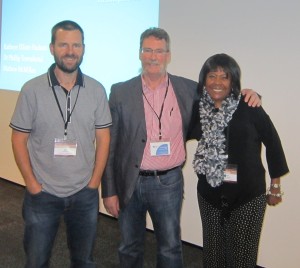
Kathryn Elliott-Hudson with co-presenters Dr. Phillip Townshend and Matthew McMillan at the 5th International Gambling Conference
I was invited to present at the 5th International Gambling Conference in Auckland, New Zealand, February 19-21, 2014. I’ll share some of the highlights of this conference, whose goal was to examine “how positive change can be brought about through research, policy, and practice.”
On February 20, I had the privilege of presenting, along with Matthew McMillan and Dr. Phillip Townshend. Our topic was “Working Toward Best Practice: Reflections from the Northern and Southern Hemispheres.” My portion of the presentation was focused on gambling in Arizona, which included information about the Office of Problem Gambling, the Treatment Assistance Program, and an historical perspective of gambling in this state. The presentation was well received, and I fielded quite a few questions during the Q&A and later at lunch.
The conference, an educational and cultural experience, was held at Auckland University of Technology (AUT), City Campus Conference Center, which was completed just in time for the conference. It was hosted by Hapai Te Hauora Tapui Maori Public Health, the Gambling and Addictions Research Centre at AUT, and the Problem Gambling Foundation of New Zealand (PGF).
Approximately 300 people representing fifteen countries attended. I was one of three U.S. presenters. Newly retired Judge Mark Farrell, a friend of mine, delivered the keynote “Therapeutic Justice: The World’s First Gambling Treatment Court” about the criminal and civil treatment court he founded in Amherst, NY in 1996.
Another keynote of particular interest was delivered by Professor Gerda Reith of the University of Glasgow on “Mobile and Social Gambling: Key Trends and Challenges for Research.” I also enjoyed the workshop “Web-Based Counseling for Problem Gambling” presented by Simone Rodda from Turning Point Alcohol and Drug Centre in Victoria, Australia.
Because the focus of the conference was on technology, each attendee received an Android tablet with a preloaded conference app so that we could view the program, information about the keynote speakers, presenter abstracts and bios, and maps of the venue. Despite a wonderful how-to video, there were many laughs as we struggled to learn to use our devices, and a call was sent out to any nearby five-year-olds who could possibly help us.
On the cultural side, the welcome powhiri was a one-time experience for a manuhiri (visitor). It was their way of officially welcoming us to Aotearoa/New Zealand and to the conference. This event took place at the sacred place or Marae, and each morning there was some sort of ritual except for one morning when we had the Pacific Welcome, songs and dance of other Pacific islands such as Tonga, Fiji, and Samoa.
A Maori expression appeared with the conference logo: Ma te korero ka mohio, Ma te mohio ka marama, Ma te marama ka matau, Ma te matau ka ora. It means: Through discussion comes understanding, through understanding comes light, through light comes wisdom, through wisdom comes wellbeing. I left the conference with a new appreciation for the potential application of technology in the counseling setting.
It is possible that the presentations will become available online in the near future, and if so, I will publish an update to this post.
